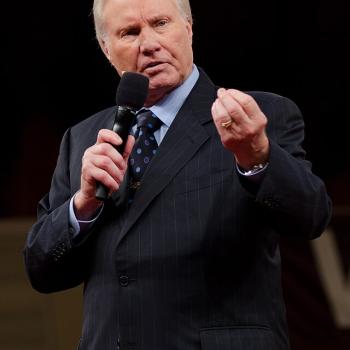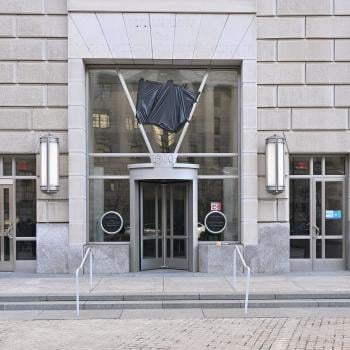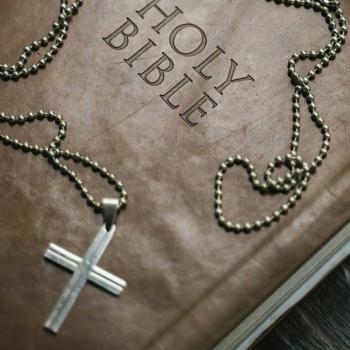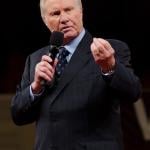Below you will find an essay entitled “Reclaiming Pietism.” It is a response to critics of Pietism such as Mark Talbot of Wheaton College (who wrote against Pietism in Modern Reformation).
Your responses are welcome.
Reclaiming Pietism
Roger E. Olson
To the man or woman on the street the term “Pietism” probably evokes a feeling of disdain if not revulsion; it conjures up images of super-spiritual, holier-than-thou religious folks strictly to be avoided. To the slightly better informed person in the pew it probably produces an only slightly more positive response; it often brings to mind memories of a beloved elderly spinster—the proverbial “church lady”–who disapproved of everything fun in the name of Christ. To the hopefully better educated person in the pulpit “Pietism” may describe a historical movement of overly emotional preachers who attempted to manipulate their listeners to have spiritual feelings that bypassed the intellect and led many of their followers to disengage from the world and eschew the life of the mind.
These and many other images of the Pietists and of Pietism linger in popular culture and among Christians who arguably have been misled about the Pietist movement and Pietism in general. I had the advantage of growing up in a family deeply influenced by Pietism where the word itself still meant something positive. My maternal grandparents were members of the Evangelical Free Church of America and several of my uncles and aunts belonged to either that denomination or its cousin the Evangelical Covenant Church of America. Other relatives were very devout and pious adherents of the Christian Reformed denomination or the Church of God (Anderson, Indiana) or the Salvation Army or some other distant offshoot of Pietism. Pietism in its true, historical sense permeated my large, extended family’s life. My stepmother prayed and sang hymns as she cleaned the house; something that made me somewhat reluctant to invite friends home after school. My grandmother sang us to the dinner table at family reunions with Charles Gabriel’s “All things are ready, come to the feast; come for the table now is spread….” Every family unit had at least one “promise box” in its kitchen or dining room and evening meals usually began with “family devotions.”
A major focus of at least one course I took in college was the Pietist movement of the 17th and 18th centuries where I learned about the great German post-Reformation Protestant church renewers Philipp Jakob Spener (1635-1705), August Hermann Francke (1663-1727) and Nicholas Ludwig Count von Zinzendorf—the “noble Jesus freak” (1700-176). And our little denomination regarded itself as a descendent of theirs. We especially loved Zinzendorf’s “intimacy with Jesus” motif. After college I attended a seminary of the German Baptist tradition steeped in Pietism and learned more about the movement; for the most part what I learned about it was positive.
So, when I encountered negative attitudes towards Pietism during my doctoral studies I was somewhat perplexed. I knew secular folks and probably liberal Protestants (to say nothing of Catholics) disdained it, but then I heard my beloved mentor in my doctoral program using “Pietist” and “pietistic” as insults. He routinely used them to label individual Christians and churches he considered overly emotional, subjective with regard to faith, anti-intellectual and detached from society and its problems. He was a Barthian Methodist and one of his favorite objects of scorn was First Methodist Church of Houston and its pastor Charles Allen, author of influential devotional books such as God’s Psychiatry. My mentor called Allen and his congregation “that warm-hearted crowd down on Main Street.” Later I learned that my mentor had grown up in a fundamentalist offshoot of the Church of the Brethren—a pietist denomination—and that he was in deep reaction against everything about it.
Then I went to Munich to study with Wolfhart Pannenberg and heard him speak disparagingly of Pietism. Several times I heard him say “There is one thing I am not and that is a Pietist.” During my tenure teaching theology at Bethel College (now Bethel University), founded by Swedish Pietists, a leading pastor of its controlling denomination said to me “Pietism is just a mask for doctrinal indifference.” An evangelical philosopher at Wheaton College wrote an article for Modern Reformation magazine entitled “What’s wrong with Pietism?” and accused it of being a negative influence on American religious life insofar as it “cuts itself loose from a doctrinally full and sound faith.”[1] All you have to do to discover this very negative treatment of Pietism is simply “google” the word. There you will encounter articles such as “How Pietism deceives Christians” which equates Pietism with spiritual elitism and concludes that “Pietism cannot help but take people’s minds off of the gospel.”[2]
All these pejorative treatments of Pietism conflicted with what I had learned of historic Pietism and most of what I experienced of Pietism during my formative years. On the other hand, many of them touched a sensitive nerve; I had sensed certain tendencies in Pietism that could, if not restrained, lead to these problems. So I decided to take up the study of Pietism for myself and I read voraciously everything I could get my hands on about its history and theology and spirituality. One person I encountered in that project was United Church of Christ theologian Donald G. Bloesch (1928-2010) who became my primary theological mentor and helped me recover a very positive sense of Pietism while being wary of its dangers.
Almost every book about Pietism opens with a similar disclaimer—that it is one of the most misunderstood and wrongly vilified movements in Christian history. Typical is Pietism scholar F. Ernest Stoeffler’s comment at the beginning of his magisterial The Rise of Evangelical Pietism that it is “one of the least understood movements in the history of Christianity.”[3] He continues by describing common stereotypes of Pietism and reasons for its rejection by many Christians, to say nothing of secularists. I agree with the thesis of Covenant theologian Michelle Clifton-Soderstrom that “Pietism has caused trouble. Nevertheless, its trouble is worth redeeming.”[4] In other words, yes, Pietism has had some deleterious effects in Protestant Christianity and perhaps the wider American society where it has become part of the fabric of popular religion. However, for the most part, those deleterious effects are based on distortions of true, historical Pietism. There is, after all, as with most movements, its classical, historical expression and what I call “Pietism gone to seed.” In spite of its distortions and their harmful consequences, especially in folk religion, I find much good in Pietism and I believe its recovery can greatly aid even mainline churches in their efforts at renewal and mission.
So, by “reclaiming Pietism” I mean rediscovering its true history, reconstructing it in a positive mode by focusing on its distinctive features, correcting misconceptions about it and recommending it for church renewal and mission in this postmodern age.
I hope to accomplish four things in this brief talk. First, I will attempt to define Pietism and offer what I consider a helpful distinction about the term. Second, I will go beyond mere definition by describing Pietism’s primary characteristics, features, hallmarks, motifs. Then, third, I will lay out and correct several of the most common myths and misconceptions about Pietism while admitting that it has inherent weaknesses of which Pietists must beware. Finally, I will try to lure you back for my second lecture by hinting at some of the benefits of a recovered and restored Pietism for Christian churches.
Defining Pietism is a notoriously challenging task. It’s a bit like the blind men and the elephant in the ancient Indian parable about different perspectives; everyone who touches Pietism tends to come away with a somewhat different definition. Pietism scholar Jonathan Strom has thoroughly explored this blooming, buzzing confusion of approaches to defining the concept in his 2002 Church History article “Problems and Promises of Pietism Research.” There he surveys several influential approaches both broad and narrow. Some scholars limit “Pietism” to the ministries of influential Pietists of the 17th and 18th centuries such as Philipp Jakob Spener and August Hermann Francke. For these scholars, Pietism died out with them leaving behind traces throughout European and American Chritianity (and, of course, through them the rest of the world). Others, however, argue that Pietism is “’nothing more and nothing less’ than the history of Protestantism in the [last] three centuries.”[5]
Here I will simply offer a sampling of influential definitions of Pietism and then outline my own approach to the formidable task of defining it. According to prominent Pietism scholar Stoeffler, Pietism is simply “experiential Protestantism”[6] that, in its early expression, constituted a “second phase of the Reformation.”[7] For him, it has no “socially perceptible form,”[8] and offers no new doctrines,[9] but is a “new emphasis” among Protestants.[10] Stoeffler prefers to think of Pietism as an “ethos” than a movement even though he recognizes, of course, that it came to special expression in a loosely organized movement in Germany associated with Spener and Francke.[11] For him this ethos and emphasis revolves around a “cornerstone” which is the doctrine and experience of rebirth.[12]
Methodist theologian Ted Campbell views Pietism as one manifestation of a larger phenomenon that he labels “the religion of the heart” that includes Puritans and Catholic mystics. “Pietism” can be used either as a general label for this religious emphasis on heartfelt experience or as a specific label for the movement inaugurated by Spener and led later by Francke and their followers. Campbell describes Pietism, in either sense, this way: “Pietism stressed personal religious experience, especially repentance (the experience of one’s own unworthiness before God and of one’s own need for grace) and sanctification (the experience of personal growth in holiness, involving progress towards complete or perfect fulfillment of God’s intention)…”[13]
Historian W. R. Ward acknowledges the inevitable ambiguity of the concept “Pietism” and argues that it can be kept to a minimum by tying it to one person—Spener, for whom “The crux…was the inner spring of spiritual vitality, the New Birth, a doctrine which became a Pietist party badge not because it was peculiar to them but because of the prominence they gave it. The essence of the matter was how best to realise [sic] the priesthood of all believers.”[14] Thus, for Ward, Pietism was part of a larger “evangelical awakening” in Europe and Great Britain that extended to North America and the term should be used only for the work of Spener and his faithful followers.
Pietist theologian Donald Durnbaugh admits it is a bold person who attempts a definition of Pietism because of its “spacious, trans-territorial and trans-confessional character.”[15] But he goes on to define it historically in terms of “affinity networks” among like-minded experiential Christians all of who looked to the Herzens-Religion of Francke and Moravian leader Zinzendorf.
German historian Hans Schneider has done more than anyone else in recent years to delineate the distinction between two types of Pietists in the 17th and 18th centuries—“churchly” and “radical.” The former, like Spener and Francke, sought to renew and reform the established churches from within while the latter, like Gottfried Arnold and the Inspirationists (today’s Amana Colonists in Iowa) left the established churches and often sought fellowship with God in small, independent groups of seekers or as individuals. Whether churchly or radical, however, Schneider says, Pietists evidenced a “shared identity”: “They considered themselves to be children of God, ‘comrades in Christ,’ and addressed one another as brothers and sisters. As a group,” he argues, “they all spoke the same language.”[16] That common language was about being “awakened” inwardly, spiritually through the Holy Spirit.
Boston University theologian Carter Lindberg acknowledges the existence of a “vast swamp of Pietism studies” that makes any approach to definition difficult.[17] However, he dares to rush in where angels fear to tread and offer a “thumbnail definition”: Pietism, he says, was and is “a Bible-centered movement concerned for holy living that flows from the regenerate heart.”[18]
This is just a sampling of scholarly attempts to define Pietism. I find none fully satisfying; perhaps Pietism is, like most religious labels, another one of those “essentially contested concepts.” However, I would not like to leave the matter there. I define Pietism by first distinguishing between two types—Pietism as a historical religious movement that sprung up in Germany and flourished beyond German borders especially in Scandinavia and North America, and Pietism as a religious ethos, an ideal type of spirituality rooted and grounded in Protestant Christianity extending from historical Pietism with antecedents and consequents. All Pietism is tied in some way to the ministries of Spener, Francke and Zinzendorf, but they had precursors such as the Protestant mystical writer Johann Arndt (1555-1621) and after they were long gone their spiritual ethos lives on in various expressions.
I prefer to treat Pietism of both types less by definition, which can be too confining and is always incomplete, than by discovering its common features, characteristics, hallmarks. On these there is greater agreement among scholars than on any definition. I believe two such features, both particular, distinctive spiritual emphases, tie all the rest together to stand at the center of a religious-spiritual-theological gestalt that is Pietism throughout the ages and today. They received classic expressions by Spener, Francke and Zinzendorf, but the ethos and its gestalt flourish today where their names are never heard. Those are the closely related concepts of the inner man and conversional piety. I’ll come back to them later. First a brief survey of others’ opinions about Pietism’s common characteristics.
Stoeffler lays out four characteristics that together made up the distinctive core or center of Pietism which he regards as a centered rather than a bounded set. The margins of Pietism may express these idiocyncractically and may place other features beside them, but Stoeffler rightly argues the movement and type must be understood from its center and not from its margins.[19] The first common, core characteristic of Pietism is the belief that “The essence of Christianity is to be found in the personally meaningful relationship of the individual to God.”[20] This is, of course, a summary of statements about true Christianity sprinkled throughout the sermons and writings of Spener, Francke, Zinzendorf and all their followers. Almost with one voice they condemned mere formal religion of “head knowledge” and argued that the purpose of all preaching should be to lead listeners into “intimate personal connection” with God through the Savior Jesus Christ. Zinzendorf may have put this somewhat more emphatically and even sentimentally than others, but all Pietists would agree with him that “The believer can converse and walk with the Savior as with an invisible friend.”[21]
The second characteristic is “religious idealism” by which Stoeffler means spiritual anti-complacency or anti-spiritual complacency.[22] Pietism always makes a distinction between merely “nominal” Christianity and “true” Christianity and says the latter involves inward transformation that effects real change in a person’s life. This Pietist emphasis was well expressed by Francke who declared that “True faith is a divine work in us, which transforms us and bestows upon us the new birth from God, which kills the old Adam, and fashions us into a man who is entirely different in heart, soul, mind, and in all his powers.”[23]
The third characteristic is the necessity of conventicles—small religious groups of true Christian believers exercising the priesthood of all believers through Bible study and prayer.[24]
Stoeffler’s fourth characteristic of Pietism is “biblical emphasis” which is not garden variety biblicism but belief in an “open Bible”—a Scripture illumined to the minds and hearts of ordinary true believers by the Holy Spirit that stands above all the pronouncements of trained theologians and churchmen.[25] Spener brings this distinctively Pietist view of the Bible to expression in his classic Pia Desideria: “[i]t is not enough that we hear the Word with our outward ear, but we must let it penetrate to our heart, so that we may hear the Holy Spirit speak there, that is, with vibrant emotion and comfort feel the sealing of the Spirit and the power of the Word.”[26]
My own study of Pietism, both as a historical movement now gone and as an ethos very much still alive, leads me to affirm two key common features, core characteristics, as essential to its identity. They are, of course, set like jewels in the setting of Protestantism as their background. The first I call conversional piety. All the early Pietist leaders with the possible exception of Spener emphasized the necessity of a definite conversion including repentance and faith with the result of regeneration. Spener emphasized repentance, faith and regeneration with less clear emphasis on a definite conversion experience. Francke had his own dramatic conversion experience and concluded from it that “I had to make a beginning anew to become a Christian.”[27] He went on to preach to everyone “Likewise, you must also be newborn by the thunder of the power of God.”[28] Similar testimonies and exhortations can be found in most Pietists even as they disagreed about how emotional this experience should be, how much feeling should accompany it (e.g., tears and sighs) and whether it had to be datable or not.
Out of conversion-regeneration would inevitably arise “progressive amendment of life,” otherwise known as sanctification. Pietism has been associated with legalism and there is no doubt some truth in that, but the early Pietists all claimed that real morality arises from a transformed, converted heart and is not real if it is imposed and accepted reluctantly. Stoeffler rightly notes that Zinzendorf, like all Pietists, insisted that the real fountain of right living is not “a set of regulations but a joyful, affective, unutterably satisfying, personal relationship with ‘the Savior’.”[29] For all the Pietists, holy living was extremely important, but it was never to be treated as drudgery or coercion; in order to be “holy” it had to flow naturally from a transformed temperament—what Scottish Puritan preacher Thomas Chalmers (1780-1847) called “the expulsive power of a new affection.”[30] For Pietists, the affections, often referred to as the “heart,” guide and direct the will.[31] The heart of a truly converted person wants to serve God with holiness of life and devotion even though perfection is eschatological.
Pietism’s second key common feature, core characteristic, essential to its identity, is the idea of the inner man. This somewhat strange idea and ideas necessarily associated with it are somewhat difficult to pin down, but it appears in virtually every Pietist tome and sermon in some way. Spener highlighted it in Pia Desideria: “Our whole Christian religion consists of the inner man or the new man, whose soul is faith and whose expressions are the fruits of life, and all sermons should be aimed at this.”[32] Of course, this notion of “inner man” is inextricably tied to conversional piety; conversion-regeneration changes the inner man which results in changes in the “outer man” which is one’s empirical “face” seen by the world at large. According to Spener and all Pietists, the gospel aims at transformation of the inner man; it is not enough for the outer man to confess doctrines correctly or practice charity or engage rightly in sacraments and liturgy. If the inner man of the person is not transformed by the Word and Spirit, all those activities of the outer man, though performed to perfection, are useless.
In fact, Pietists go further and claim that Christ’s own death on the cross is of no use to the outer man until the inner man is touched by it. Pietist Philip William Otterbein (1726-1813) famously declared “Christ and his death do us no good unless Christ enters within us, destroying the kingdom of Satan within us, penetrating and renewing our spirit, soul, and body with His light and life.”[33] Otterbein’s exact form of expression may be his alone, but all Pietists going back to Spener would agree. Francke scholar Gary Sattler argues that for Francke and all Pietists “the starting point and primary concern…is the inner person.”[34] According to him, the “inner person” designates the heart, soul, conscience and mind.[35] I would add that “heart” here means “affections”—what is loved and desired. The “inner man,” then, is the individual’s virtue-inclinations, what he or she naturally and without external or internal compulsion “leans into.” It is this dimension of the person preaching appeals to, the Word and Spirit touch, responds with cooperation in repentance and faith (all the Pietists were synergists), is transformed by God in conversion-regeneration, desires and enjoys fellowship with God, lives devoutly and piously, and progressively bends the outer man toward holiness. Francke compared this with the life of a tree: “Following Christ begins in an interior way and it moves out into the exterior and this can be understood in the similitude of a tree.”[36] In other words, the roots must be healthy for the branches and leaves to flourish.
Other hallmarks, key characteristics and features, core concerns and commitments, might be identified as essential to either historic Pietism or the Pietist ethos or both. Stoeffler mentioned conventicles, small groups, collegia pietatis as a hallmark. That would be true especially of the historical movement; whether it is required for a Pietist ethos is debatable. Certainly there have been Pietists throughout the last couple, three centuries who have not emphasized that. I consider that more a contribution of the Pietist movement to the church in general than as a necessary feature of the Pietist ethos. One could also debate eschatology and its relationship with Pietism. Most scholars point out that Spener and Francke and many of their followers were chiliasts—millennialists of some kind. Strom considers this one of historical Pietism’s essential features.[37] Without doubt Spener was a kind of postmillennialist; he believed in a coming new day of “better times” for church and society to be inaugurated by God himself with human participation. His program for reform of church and society was meant to speed things along toward the kingdom of God on earth. Francke was not as openly postmillennial, but he did practice something critic Richard Gawthrop labels a “promethean spirituality” intended to transform all of society through changing individuals’ lives.[38] Without doubt many radical Pietists engaged in apocalyptic speculations and some even attempted to set the date of Christ’s return.[39] However, I do not consider millennialism or apocalypticism or focus on eschatology any essential part of the Pietist ethos.
I began by mentioning that Pietism has a bad reputation. Why would it? Don’t most American Christians believe many of these same things? Well, at least many do—especially those who called themselves “evangelicals” before the Religious Right hijacked the label. My argument is that true, historical Pietism and the Pietist ethos played and continue to play a major role in contemporary evangelical faith. However, not everyone has a positive impression of Pietism and that includes many who proudly wear the label “evangelical.” Certainly many so-called “mainline” critics have negative impressions of it and not all of them are mere stereotypes derived from ignorance. Pietism was controversial during its heyday as a movement and it has continued to be controversial. What I want to do here is clear up some of the most common myths and misconceptions about Pietism that make it controversial while admitting that it has some inherent weaknesses even Pietists should watch out for.
Great controversy and debate surrounded Pietism in its early stages. Spener was a very cautious promoter of Pietism who quoted Luther often and claimed to agree with everything Luther taught, but he was still accused by his opponents—mostly preachers of the so-called “orthodox party” within the Lutheran state churches—of 283 heretical teachings.[40] He survived the charges and accusations because repeated government investigations acquitted Spener, Francke and other Pietist leaders within the state churches of charges of heresy and corruption. Nevertheless, Spener had to leave Frankfurt where he served as a kind of district superintendent over many Lutheran parishes and then also Dresden where he was court chaplain. He ended up in Berlin, protected by the Elector Prince of Prussia Frederick William who eventually embraced Pietism. His critics made his life a living hell anyway. The same was true for Francke who was constantly refuting spurious charges and accusations. Like Spener, he was protected by the king. Zinzendorf was not so lucky; his controversial words and ways caused him to be banished from his homeland of Saxony on more than one occasion.
What were and are the main accusations leveled against Pietism by religious critics? (I’ll leave aside secular critics here, most of whom consider Pietism simply religious fanaticism.) Among the more prominent and partly true ones are religious subjectivism and individualism, anti-intellectualism, other-worldly quietism, rejection of the key Protestant doctrine of justification by faith, in other words, semi-Pelagianism, and harsh legalism. All these can be found sprinkled throughout books against Pietism such as Albrecht Ritschl’s famous three volume History of Pietism where the influential 19th century German Lutheran theologian concluded that Pietism was more akin to medieval, catholic, monastic, mysticism and asceticism than to Protestantism.[41] Karl Barth had a running battle with Pietism even though he admitted its influence on his own theology through Franz Overbeck (1837-1905) and the Blumhardts Johann (1805-1880) and Christoph (1842-1919).[42] According to Barth, Pietism amounts to “religious individualism” and “quietism”—a flight from the world. He also accused it of semi-Pelagianism meaning that it emphasized too much the human contribution to salvation and devalued the sovereignty of God in salvation.[43]
Here it will only be possible to respond to some of the major charges and accusations against Pietism. I will focus on claims that it is subjective and anti-intellectual, quietistic and otherworldly and semi-Pelagian or insufficiently Protestant.
What about the claim that Pietism is endemically subjective and anti-intellectual with regard to doctrine and theology? Defenders of Spener and Francke have shown conclusively that they did not reject the life of the mind; they simply considered much theology speculative and a distraction from the point of Christianity. Stoeffler rightly notes that “Pietists like Spener [i.e., churchly Pietists] constantly warned their followers against the dangers of subjectivism.”[44] Spener and Francke also insisted on thorough catechesis of children and converts.[45] But the main focus of negative attention has been on Zinzendorf because of his colorful rejections of systematic theology. He liked often to say that as soon as you have put Christianity into a system you have killed it. He stood against all rationalistic approaches to Christianity because he believed the transcendence of God inevitably includes mystery and ends in paradox. But most importantly, he considered systematic theology and rational apologetics alien to the personal nature of faith: “Forcing religion into a fine-spun rational harmony was [for him] no substitute for faith, indeed it made faith harder by creating the impression that belief was a mathematical problem.”[46] In a typical Zinzendorf-ian way the Count appealed to theologians to avoid turning faith into a head trip:
Here one would like for God’s sake to beg all theologians, if they would only listen, not to take such pains constantly to represent our religion as agreeing with reason, as being common sense. If writings of this kind are assigned as pamphlets, by which people earn a living for themselves, then it may pass. But as soon as it is taken seriously, as soon as they want to demonstrate to atheists and common deists and people like that that our religion is a wisdom rooted in their heads, a discernment which they can take in their own way, then they are obviously threshing empty straw, according to all instruction of the Scripture.[47]
On the other hand, in spite of this aversion to highly rational, systematized theology, Zinzendorf was himself a student of theology and widely read in philosophy. Spener and Francke and later Pietists such as the great biblical scholar Johann Albrecht Bengel (1687-1752) were avid students of Scripture, including the original languages and commentaries, and taught their parishioners and students to read and study. Admittedly, for the most part, they had little use for Enlightenment philosophy that was budding during their lifetimes. With Blaise Pascal they would respond to Descartes with the query “Do you love by reason?” Still, there is very little evidence that the original Pietists were “fools for Christ’s sake” or promoted ignorance. In fact, the evidence points in the opposite direction. Pietism scholar James Tanis waxes eloquent about the early Pietists’ “zeal for higher education”[48]
Is there, nevertheless, an inherently anti-intellectual bent in the Pietist ethos? I think that is entirely possible; many Pietists have abandoned scholarly pursuits referring to seminary as “cemetery” and warning students of theology such as myself “Remember, there is such a thing as an over educated idiot!” (Which is what a Pietist uncle said to me the day before I left to study with Pannenberg in Munich!) But anti-intellectualism and subjectivism are not necessarily tied only to Pietism; they are part of the very fabric of American society. I would argue that subjectivism and anti-intellectualism are not proper to Pietism, per se, but are evidences of its decline from the vision of its founders and early leaders. Theologian Donald Bloesch, mentioned earlier as in many ways my mentor, was anything but subjectivist or anti-intellectual even thought he did wish to preserve the priority of faith over reason in matters of Christian truth.[49] He was widely read in philosophy, theology and biblical studies, a student of culture and a prolific writer of scholarly treatises on theology, ethics and spirituality. If he was anti-intellectual or subjectivist it would only be because he elevated revelation and faith over a foundationalist approach to theology.
Pietism has often been charged with being quietistic and other-worldly. How true is that accusation? Again, I will argue that it is untrue with regard to the Pietist movement while it may have some validity with regard to the Pietist ethos as it came to expression after Spener, Francke and Zinzendorf and their followers. However, many Pietist leaders after them have evinced strong ethical commitments and have even been active in something akin to the social gospel.
Lutheran Pietism scholar Paul R. Kuenning sets out in The Rise and Fall of American Lutheran Pietism to show that true Pietism has never been and is not other-worldly or quietistic. With regard to the charge of quietism he says
German Lutheran Pietism has often been characterized as quietistic or otherworldly, as fostering a subjective spirituality that retreated into its own world of mystical asceticism or private piety. The inaccuracy of these descriptions when applied to the classical Lutheran Pietism of the Spener-Francke school becomes apparent through even a cursory examination of its exuberant ethical activism.[50]
Like many other scholars of Pietism, Kuenning runs through a long list of Pietists who have demonstrated social concern including especially Francke, who set out through his Halle Institutions, to transform Prussian society and the world. Especially Württemberg Pietism as lived out by such leading lights as Bengel, Oettinger and the Blumhardts was socially and politically engaged in very progressive ways. This has been demonstrated by Pietism scholar Frank D. Macchia in Spirituality and Social Liberation (Metuchen, NJ: The Scarecrow Press, 1993). Kuenning concludes that
In summary, German Lutheran Pietism exhibited on all levels a concern for the poor and the oppressed that was advanced for its day and an ethical activism without precedent in the history of Lutheranism. From a twentieth-century perspective it may well be accused of advocating a band-aid approach to social problems, but there can be little question that it made a solid contribution to an expanding concept of social justice. It contained the impetus and the biblical-theological rationale for the moral crusades, abolitionists, and Social Gospelers of the nineteenth century.[51]
Kuenning does not leave the matter with assertions like that; his entire book is a close
examination of two particular case studies of Pietist and Revivalist Lutheranism in ante-bellum America. Lutheran Pietist pastor and leader J. G. Schmucker (1771-1854) was a powerful preacher, revivalist, seminary founder (Gettysburg Seminary) moral reformer and a confessional Lutheran who took a leading role in abolitionism—something for which he paid a high personal price. During the same ante-bellum period there was a strong anti-slavery German Lutheran synod called the Franckean Synod—after August Hermann Francke. It was centered in upstate New York and took an uncompromising stand against slavery. It was also thoroughly revivalistic. The synod ordained the first black person to Lutheran ministry.[52] Time and space prohibit a lengthy description of either Schmucker or the Franckean Synod; suffice it to say here that they disprove any claim that Pietism is inherently quietistic or other-worldly.
Is it possible, however, that a quietistic and other-worldly tendency lurks within the Pietist ethos? I consider that a very real possibility. Like every religious ethos Pietism harbors certain tendencies that, if taken too far, have deleterious effects. Certainly the Pietists I grew up around were quietistic and other-worldly. One possible explanation is evangelical Christianity’s turn toward premillennialism and even dispensational apocalypticism in the post-Civil War era under the influences of D. L. Moody and fundamentalism. It may be that many Pietists got caught up in these, exacerbating a natural tendency of any strongly inward-looking spiritual movement to abandon hope for the world.
Finally, what about the accusation that Pietism is inherently semi-Pelagian and non-Protestant because of a focus on good works and the human contribution to salvation? Again, I think there may be some truth to this with regard to the Pietist ethos, especially as it has deviated from the intentions of the leaders of the Pietist movement. Pietism has always emphasized the human person’s participation in his or her salvation, but the original Pietists were careful to preserve the divine initiative and to emphasize that salvation is all of God’s grace and received through faith alone.
Certainly Spener, Francke and Zinzendorf, as well as their followers, placed the emphasis of soteriology on conversion and regeneration, but they never denied objective justification. According to Brown, “Spener felt that the Johannine and Pauline metaphor of regeneration represented a completion and an enhancement rather than a replacement of the equally biblical metaphor of justification.”[53] Sattler rightly notes that Francke agreed entirely with Luther about salvation being all God’s doing: “Seen theocentrically, all that happens [in salvation] is of God. Experienced anthropocentrically, there is human effort required and expended in the cleansing of one’s heart.”[54] Otterbein totally rejected any medieval-like system of penitential merit and preached that “It is…certain that we can deserve eternal blessedness neither fully nor in part. It is certain that everything is by free grace and that we become blessed by grace.”[55] But, like most Pietists, Otterbein also preached that “It is…equally certain that, in spite of all this, diligence in good works, or a pious, godly life, is absolutely necessary.”[56] However, like all early Pietists, he made clear that good works are done by the regenerate out of gratitude and to honor and praise God and not because justification depends on them.[57]
Perhaps no amount of quoting early Pietists will satisfy those who suspect Pietism harbors some hidden emphasis on merit in salvation; Calvinists always think that about Arminians even as Arminians vehemently deny it and affirm that salvation is initiated by God and that God does all the “work” of saving. However, most of the early and later Pietist theologians have strongly affirmed justification even as they have attempted to recover a Protestant emphasis on devout and holy living. Once again I point to Bloesch as my example. He adamantly affirms that salvation is all of God’s grace and that justification and sanctification are distinct moments in the drama of salvation. However, he sides with the Pietists and says this is something we can learn from them: “While acknowledging the logical priority of justification, they remind us of its inseparable connection with sanctification. They concur in the judgment of the Reformers that God loves us as we are; but they go on to affirm that God wants us as He is.”[58]
What I suspect really annoys many Protestant critics of Pietism is its stress on decision; to some people strongly allergic to any human participation in the act of salvation this inevitably rings of works righteousness. And, perhaps this is simply one of those watersheds in theology that cannot be leveled. Bloesch expresses the classical Pietist commitment well: “Man is not yet saved until he lays hold of this justification in the decision of faith. God has acted decisively for our salvation, but we must respond to His saving offer even though we can do this only through His Spirit.”[59]
Do many Pietists fall into a kind of implicit works righteousness by over emphasizing human decision to the neglect of divine initiative and empowerment? I don’t doubt it. There may be that weakness inherent in Pietism to be guarded against. However, my own study of the early Pietists and later leading lights of Pietism has led me to conclude they agreed completely with Luther and the other Reformers that salvation is all of God’s grace and that even our first steps toward God are made possible by grace.
What I have attempted to accomplish here is to retrieve Pietism and repair its reputation as much as possible in such a brief presentation. I have also attempted to be as objective as possible and admit where Pietism has its weaknesses. It is my studied opinion that, in spite of its inherent negative tendencies, Pietism, rightly understood in terms of its historical foundations and its basic spiritual-theological ethos, has much to contribute to Christianity in this postmodern age. I will unpack that thesis in more detail in my second presentation. Here I will just comment on a few such possible, positive contributions.
First, a recovered, restored Pietism, purified of extremes to which it has sometimes been taken, can help infuse life into dried up and dying congregations. This was, of course, the main goal of the original Pietists, especially those I have focused on as “churchly Pietists” who did not shake the dust off their shoes and abandon the established churches for individualistic spirituality.
I agree with Stoeffler who corrected misconceptions about the Pietist movement as sentimental enthusiasts reveling in emotion for its own sake. Rather, he avers,
The leading Pietists were sober men who were considerably more concerned about cross bearing and the moral reformation of the person than about pleasurable feeling states, though it is highly questionable whether or not the latter can or should be completely eliminated from a personally meaningful religious faith. What they endeavored to do was to correct the then current dry-as-dust orthodoxy in favor of the Christianity of the reformers, which was a living, vital, and hence affectively satisfying faith.[60]
Every other scholar of early Pietism that I have read has said much the same about men like Spener, Francke, Zinzendorf, Arnold, Tersteegan, Oetinger, Bengel, et al. Their focus was on church renewal and vitality, not on positive feelings for their own sakes.
Bloesch, the late 20th century evangelical theologian, who was also “mainline” and a Pietist, emphasized experience of the living God that is life and world transforming over a theology of glory that is often the sign of a Pietism gone to seed. He fought both quietistic mysticism and radical religious enthusiasm while affirming “faith as a living experience as well as decision and trust.”[61] Bloesch spoke often of the Christian life as a drama and a battle that transcends mere ritual or dogma. “We affirm,” he wrote, “that the life of devotion is the battleground on which our salvation is fought for and continually recovered.”[62]
So what does all this have to do with church renewal and vitality? What is missing from many congregations is any sense of struggle except struggling to maintain the institution. Pietism injects a sense of dynamic tension and victory into Christian living; it insists that the primary purpose of Christianity is transformation, not mere information or organization. Too often mainline pastors and their congregations think that any emphasis on transformative spirituality has to be tied to charismatic phenomena and so they step away from spiritual experience that touches the affections entirely. But why is it okay to cry at a movie but not in church? Why is it okay to get excited at a sports event but not during worship or in prayer? And why do these evidences of life have to be fanatical or weird or frightening? Pietism is a mostly unexplored vast region of Christian spirituality between dead orthodoxy and ritualism on the one hand, and charismatic-Pentecostalism on the other.
Closely tied to that first proposed contribution of Pietism is a second. A recovered and restored Pietism, stripped of extremes and filled with rich content as intended by its founders, can appeal to individuals’ desire for spiritual experience. Too often pastors and congregational leaders are so frightened of fanaticism and religious weirdness that they back away entirely from the whole idea of experiencing God through Jesus Christ in the power of the Holy Spirit. But this is to ignore the natural craving to feel something and be changed that lies deep within the human breast. We are not made to live by doctrines and ceremonies alone; while we are shoving religious experience (except perhaps a quiet Yoga meditation class in the basement) out the door, people are seeking spiritual experience wherever they can find it. Pietism insists that authentic Christianity will always include an appeal to affections and not only intellect or will. Pietist scholar Hansgünter Ludewig’s description of Pietist Gerhard Tersteegen (1697-1769) well expresses the longing of most, if not every, human heart: “His quest was less for a gracious God than for the presence of God. He desired to know by living experience that God is with him.”[63] Many, if not most, people today are, like Tersteegen, less concerned about issues of guilt and justification than about issues of God’s personal presence with and in them. Pietism points the way toward a non-fanatical, experiential Christianity that brings transformation and assurance through a personal relationship with God that is felt and not only promised.
The third proposed positive contribution of Pietism to a renewed Christianity is a practical expression of faith that springs from inward desire and not fear or manipulation. The entire emphasis of the Pietists and of the Pietist ethos, at its best, is on holy living and that is not meant to be mere legalism. Bloesch states boldly that sanctification, a major emphasis of Pietism, is not about outward conformity to a code of conduct, but it is “concerned with the development of a holy personality.”[64] What does this look like in recovered, restored Pietism? Bloesch makes clear it is not about Puritanical self-righteousness. It is rather about attaining “a spiritual maturity that mirrors and proclaims the perfect holiness of Jesus Christ.”[65] Like many others who have recently rediscovered true Pietism, Bloesch argues that this transformed, holy personality will not turn inward upon itself in mystical navel gazing. Rather, “The converted sinner will be primarily concerned about the spiritual lostness of man, but he will also agonize over the injustices that the lost condition of man engenders.”[66]
Pietist theologian Clifton-Soderstrom emphasizes this practical, outward dimension of Pietism that strives for the transformation of society and not just the individual. According to her, but not only her, “at the heart of Pietist ethics are [sic] a practice-centered ethic that finds its source in the formation of Christian character.” “In a sense,” she continues, “the external life was about giving everything back to God. The beauty of their Christian ethic was that they enacted justice, compassion, mercy and evangelism along the way.”[67] She advocates a sense of Pietism as virtue ethics; the point of devotion is to form compassionate character. She points back to Spener, Francke, Zinzendorf and even radical Pietists such as Johanna Eleonora Peterson (1644-1724) as examples of activist Pietists who sought church and social transformation through activism on behalf of the poor and oppressed.
Pietism aims at the inward transformation of the affections leading to change of the will resulting in acts of compassion. Too often our churches try to manipulate congregants into giving and working because there is no inner impulse giving rise gratefully and voluntarily to these practices. A dose of spiritual experience brought about through repentance and faith in response to powerful preaching of the cross just might result in more kingdom building than all the appeals we make in our newsletters and from our pulpits. I hesitate to appeal to my own experience in what is supposed to be a scholarly presentation, but I once belonged to a church that refused to beg for money or for volunteers and yet had more than enough of both all the time. Why? Because congregants saw with their own eyes lives being transformed by the power of God and heard powerful testimonies of such transformation from society’s castaways. That church today, though relatively small, is a channel of tangible blessing to thousands of hungry people in its community every year.
Finally, I suggest that a recovered and restored Pietism can help make theology relevant to postmodern young people seeking something other than dry, scholastic, rationalistic systems of dogma or naturalistic theologies accommodated to the now dying Enlightenment culture of anthropocentrism. I recall vividly the paradoxes of student life at Rice University when I was studying for my Ph.D. in religious studies. Rice is a bastion of naturalism and scientism; it’s strange that it contains a Religious Studies Department. The majority of students at Rice are majoring in the so-called hard, physical sciences; that’s what it is known for. Yet, as I helped teach courses such as “Deity, Mysticism and the Occult” I discovered a lively underground of interest in esoteric religion among the students. I remember one event especially well. We hosted a troupe of Sufi mystics—literally whirling dervishes—who arrived in full Sufi regalia on a bus. They marched into the large banquet-conference hall and stood in a circle around their “Pir” or leader who then directed them in their elaborate dances of mystical rapture until they collapsed on the floor in exhaustion.
What fascinated me were the many students watching this energetic display of mysticism in meditative solidarity with the Sufis. Many students who I knew to be studying engineering and molecular science and nuclear physics were sitting there in lotus positions, eyes mostly closed, chanting under their breath as the Sufis danced. I also became aware of groups of students studying and practicing Wicca and Eckankar and Scientology and many other esoteric religions. For the most part, appeals to rationalistic Christian apologetics put on by fundamentalists were laughed out of court by these daytime scientists and nighttime occultists.
During those days Martin Marty visited the campus and talked about cults and new religions in America. It was the era of Jim Jones and the People’s Temple, Krishna Consciousness and even Satanism. Someone asked Marty how these cults could flourish in the modern age of reason and natural science. I’ll never forget Marty’s words. He said “When the naturalistic policemen of modern science beat people over the heads with their secular nightsticks, the people start smuggling the gods in brown paper bags.”
I believe a recovered and restored, that is purified, Pietism can help mainline Christian churches provide that much needed experiential dimension so many people seek in religion without borrowing from Eastern religions or esotericism and without becoming charismatic (not that there’s anything wrong with that!).
[1] Mark R. Talbot, “What’s wrong with Pietism?,” Modern Reformation (March, 2002).
[2] Bob DeWay, “How Pietism Deceives Christians: The Errors of Elitist Teachings in the Church” at “Critical Issues Commentary” blog: http://cicministry.org/commentary/issue101.htm.
[3] F. Ernest Stoeffler, The Rise of Evangelical Pietism (Leiden: E. J. Brill, 1971), 1.
[4] Michelle A. Clifton-Soderstrom, Angels, Worms, and Bogeys: The Christian Ethic of Pietism (Eugene, OR: Cascade Books, 2010), 10.
[5] Jonathan Strom, “Problems and Promises of Pietism Research,” Church History 71:3 (September, 2002), 549.
[6] Stoeffler, Rise, 8.
[7] Ibid., 23.
[8] Ibid., 12-13.
[9] Ibid., 15.
[10] Ibid.
[11] Ibid., 9.
[12] Ibid., 72.
[13] Ted Campbell, The Religion of the Heart: A Study of European Religious Life in the Seventheenth and Eighteenth Centuries (Columbia, S.C.: University of South Carolina Press, 1991), 71.
[14] W. R. Ward, The Protestant Evangelical Awakening (Cambridge, UK: Cambridge University Press, 1992), 57.
[15] D. F. Durnbaugh, “Communication Networks as One Aspect of Pietist Definition,” Pietism in Germany and North America 1680-1820, eds., Jonathan Strom, Hartmut Lehmann, James Van Horn Melton (Burlington, VT: Ashgate, 2009), 33, 49.
[16] Hans Schneider, German Radical Pietism, trans., Gerald T. MacDonald (Lanham, MD: The Scarecrow Press, 2007), 185.
[17] Carter Lindberg, “Introduction” in The Pietist Theologians (Blackwell, 2005), 2.
[18] Ibid., 4.
[19] Stoeffler, Rise, 12.
[20] Ibid., 13.
[21] Peter Vogt, “Nicholas Ludwig von Zinzendorf (1700-1760)” in Lindberg, The Pietist Theologians, 213.
[22] Stoeffler, Rise, 16.
[23] Quoted in F. Ernest Stoeffler, German Pietism During the Eighteenth Century (Leiden: E. J. Brill, 1973), 8.
[24] Stoeffler, Rise, 19. No quote is provided here simply because most of the early Pietists did not comment on this essential idea, but all practiced it. Spener instituted conventicles during his pastorate in Frankfurt and described their importance in Pia Desideria, 87-90.
[25] Ibid., 20-22.
[26] Philip Jakob Spener, Pia Desideria, trans., Theodore G. Tappert (Philadelphia, PA: Fortress Press, 1964), 117.
[27] Emilie Griffin and Peter C. Erb, eds., The Pietists: Selected Writings (San Francisco, CA: HarperSanFrancisco, 2006), 44.
[28] Ibid., 59.
[29] Stoeffler, German Pietism, 153.
[30]See http://network.org/christian-beliefs/the-holy-spirit-and-christian-living/getting-stuck-in/the-expulsive-power-of-a-new-affection.htm.
[31] Gary R. Sattler, Nobler than the Angels, Lower than a Worm: The Pietist View of the Individual in the Writings of Heinrich Müller and August Hermann Francke (Lanham, MD: University of America Press, 1989), 73.
[32] Spener, Pia Desideria, 116.
[33] Quoted in J. Steven O’Malley, Early German-American Evangelicalism (Lanham, MD: The Scarecrow Press, 1995), 29.
[34] Sattler, Nobler than the Angels, 41.
[35] Ibid., 43.
[36] August Hermann Francke, “On Christian Perfection” in Pietists: Selected Writings, ed., Peter C. Erb (New York, Ramsey, Toronto: Paulist Press, 1983), 138.
[37] Jonathan Strom, “Introduction,” Pietism in Germany and North America 1680-1820, 2.
[38] Richard L. Gawthrop, Pietism and the Making of Eighteenth Century Prussia (Cambridge, UK: Cambridge University Press, 1993), 149.
[39] For example, Pietist leader Johann Albrecht Bengel (1687-1752), a widely acclaimed biblical scholar and member of parliament, set the date of Christ’s return as June 18, 1836! See Lindberg, The Pietist Theologians, 231.
[40] Justo Gonzalez, A History of Christian Thought, Volume III, rev. ed. (Nashville, TN: Abingdon Press, 1987), 302.
[41] See for example, Hartmut Lehman, “Pietism in the World of Transatlantic Religious Revivals,” in Pietism in Germany and North America, 14.
[42] See Eberhard Busch, Karl Barth and the Pietists, trans., Daniel Bloesch and Donald Dayton (Downers Grove, IL: InterVarsity Press, 2004).
[43] These accusations are scattered throughout Busch’s volume but especially pages 29-113.
[44] Stoeffler, Rise, 10.
[45] See Clifton-Soderstrom, Angels, Worms, and Bogeys, 35-36.
[46] Ward, The Protestant Evangelical Awakening, 123.
[47] Nicholas Ludwig Count von Zinzendorf, Nine Public Lectures on Important Subjects, translated and edited by George W. Forell (Iowa City, IA: University of Iowa Press, 1973), 78.
[48] James Tanis, “Reformed Pietism in Colonial America” in Continental Pietism and Early American Christianity (Grand Rapids, MI: Eerdmans, 1976), 57, 67.
[49] No doubt some would consider Bloesch’s approach to theology anti-intellectual because of his “fideistic revelationism” as expressed in The Ground of Certainty (Eugene, OR: Wipf & Stock, 2002). However, he was not anti-intellectual in the sense of eschewing higher education or ignoring the findings of science or encouraging blind faith or ignorance.
[50] Paul P. Kuenning, The Rise and Fall of American Lutheran Pietism (Macon, GA: Mercer University Press, 1988), 13.
[51] Ibid., 16-17.
[52] Ibid, 139.
[53] Brown, Understanding Pietism, 37.
[54] Sattler, Nobler than the Angels, 49.
[55] O’Malley, Early German-American Evangelicalism, 75.
[56] Ibid.
[57] Ibid., 77.
[58] Bloesch, The Crisis of Piety, 43.
[59] Ibid., 29.
[60] Stoeffler, Rise, 10-11.
[61] Bloesch, Crisis, 158.
[62] Ibid., 16.
[63] Hansgünter Ludewig, “Gerhard Tersteegen (1697-1769)” in The Pietist Theologians, 193.
[64] Bloesch, Crisis, 85-86.
[65] Ibid., 89.
[66] Ibid., 93.
[67] Clifton-Soderstrom, Angels, Worms, and Bogeys, 16-17.












